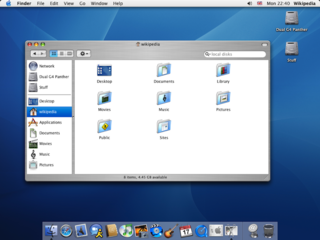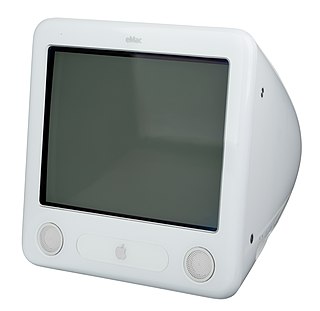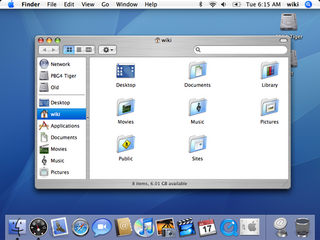
macOS, originally Mac OS X, previously shortened as OS X, is an operating system developed and marketed by Apple Inc. since 2001. It is the primary operating system for Apple's Mac computers. Within the market of desktop and laptop computers, it is the second most widely used desktop OS, after Microsoft Windows and ahead of all Linux distributions, including ChromeOS.

The Power Macintosh, later Power Mac, is a family of personal computers designed, manufactured, and sold by Apple Computer, Inc as the core of the Macintosh brand from March 1994 until August 2006.

Mac OS X Server is a series of discontinued Unix-like server operating systems developed by Apple Inc. based on macOS. It provided server functionality and system administration tools, and tools to manage both macOS-based computers and iOS-based devices, network services such as a mail transfer agent, AFP and SMB servers, an LDAP server, and a domain name server, as well as server applications including a Web server, database, and calendar server.
The history of macOS, Apple's current Mac operating system formerly named Mac OS X until 2011 and then OS X until 2016, began with the company's project to replace its "classic" Mac OS. That system, up to and including its final release Mac OS 9, was a direct descendant of the operating system Apple had used in its Mac computers since their introduction in 1984. However, the current macOS is a UNIX operating system built on technology that had been developed at NeXT from the 1980s until Apple purchased the company in early 1997.

Mac OS 9 is the ninth and final major release of Apple's classic Mac OS operating system which was succeeded by Mac OS X 10.0 in 2001, starting the Mac OS X family of operating systems. Introduced on October 23, 1999, it was promoted by Apple as "The Best Internet Operating System Ever", highlighting Sherlock 2’s Internet search capabilities, integration with Apple's free online services known as iTools and improved Open Transport networking. While Mac OS 9 lacks protected memory and full pre-emptive multitasking, lasting improvements include the introduction of an automated Software Update engine and support for multiple users.
Macworld/iWorld was an information technology trade show with conference tracks dedicated to Apple's Mac platform. It was held annually in the United States during January. Originally Macworld Expo and then Macworld Conference & Exposition, the gathering dates back to 1985. The conference was organized by International Data Group (IDG), co-publisher of Macworld magazine.

The Xserve is a series of rack-mounted servers manufactured by Apple Inc. between 2002 and 2011. It was Apple's first rack-mounted server, and could function as a file server, web server or run high-performance computing applications in clusters – a dedicated cluster Xserve, the Xserve Cluster Node, without a video card and optical drives was also available. The first Xserve had a PowerPC G4 processor, replaced by a PowerPC G5 in 2004, and by Intel Xeon processors in 2006; each was available in single-processor and dual-processor configurations. The Xserve was discontinued in 2011, and replaced with the Mac Pro Server and the Mac Mini Server.

Mac OS X Panther is the fourth major release of macOS, Apple's desktop and server operating system. It followed Mac OS X Jaguar and preceded Mac OS X Tiger. It was released on October 24, 2003, with the retail price of US$129 for a single user and US$199 for a five user, family license.

The eMac is a discontinued all-in-one Mac desktop computer that was produced and designed by Apple Computer. Released in 2002, it was originally aimed at the education market but was later made available as a cheaper mass-market alternative to Apple's "Sunflower" iMac G4. The eMac was pulled from retail on October 12, 2005, and was again sold exclusively to educational institutions thereafter. It was discontinued by Apple on July 5, 2006, and replaced by a cheaper, low-end iMac G5 that, like the eMac, was exclusively sold to educational institutions.

Mac OS X 10.1 is the second major release of macOS, Apple's desktop and server operating system. It superseded Mac OS X 10.0 and preceded Mac OS X Jaguar. Mac OS X 10.1 was released on September 25, 2001, as a free update for Mac OS X 10.0 users. The operating system was handed out for no charge by Apple employees after Steve Jobs' keynote speech at the Seybold publishing conference in San Francisco. It was subsequently distributed to Mac users on October 25, 2001, at Apple Stores and other retail stores that carried Apple products.

Mac OS X 10.0 is the first major release of Mac OS X, Apple's desktop and server operating system. It was released on March 24, 2001, for a price of $129 after a public beta.

Mac OS X Tiger is the 5th major release of macOS, Apple's desktop and server operating system for Mac computers. Tiger was released to the public on April 29, 2005 for US$129.95 as the successor to Mac OS X 10.3 Panther. Included features were a fast searching system called Spotlight, a new version of the Safari web browser, Dashboard, a new 'Unified' theme, and improved support for 64-bit addressing on Power Mac G5s. Mac OS X 10.4 Tiger also had a number of additional features that Microsoft had spent several years struggling to add to Windows with acceptable performance, such as fast file searching and improved graphics processing.

Mac OS X Leopard is the sixth major release of macOS, Apple's desktop and server operating system for Macintosh computers. Leopard was released on October 26, 2007 as the successor of Mac OS X Tiger, and is available in two editions: a desktop version suitable for personal computers, and a server version, Mac OS X Server. It retailed for $129 for the desktop version and $499 for Server. Leopard was superseded by Mac OS X Snow Leopard in 2009. Mac OS X Leopard is the last version of macOS that supports the PowerPC architecture as its successor, Mac OS X Snow Leopard, functions solely on Intel based Macs.
Two major families of Mac operating systems were developed by Apple Inc.

BootX is a software-based bootloader designed and developed by Apple Inc. for use on the company's Macintosh computer range. BootX is used to prepare the computer for use, by loading all required device drivers and then starting-up Mac OS X by booting the kernel on all PowerPC Macintoshes running the Mac OS X 10.2 operating system or later versions.
The classic Macintosh startup sequence includes hardware tests which may trigger the startup chime, Happy Mac, Sad Mac, and Chimes of Death. On Macs running macOS Big Sur or later, the startup sound is enabled by default. However, it can be disabled by the user within System Preferences or System Settings.

Mac OS is the series of operating systems developed for the Macintosh family of personal computers by Apple Computer, Inc. from 1984 to 2001, starting with System 1 and ending with Mac OS 9. The Macintosh operating system is credited with having popularized the graphical user interface concept. It was included with every Macintosh that was sold during the era in which it was developed, and many updates to the system software were done in conjunction with the introduction of new Macintosh systems.















